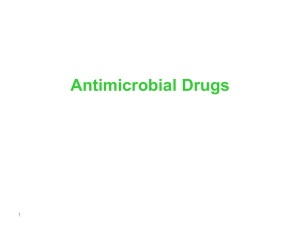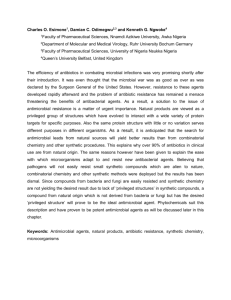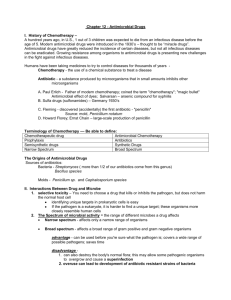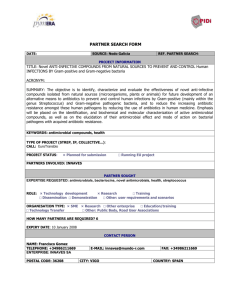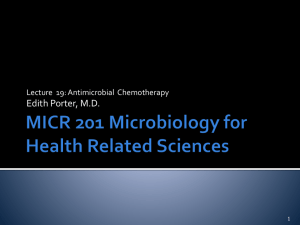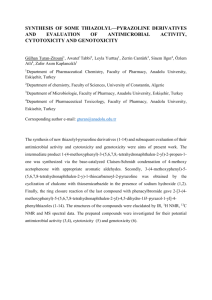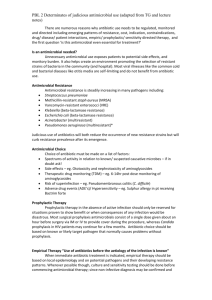Chapter 13 - SCF Faculty Site Homepage
advertisement
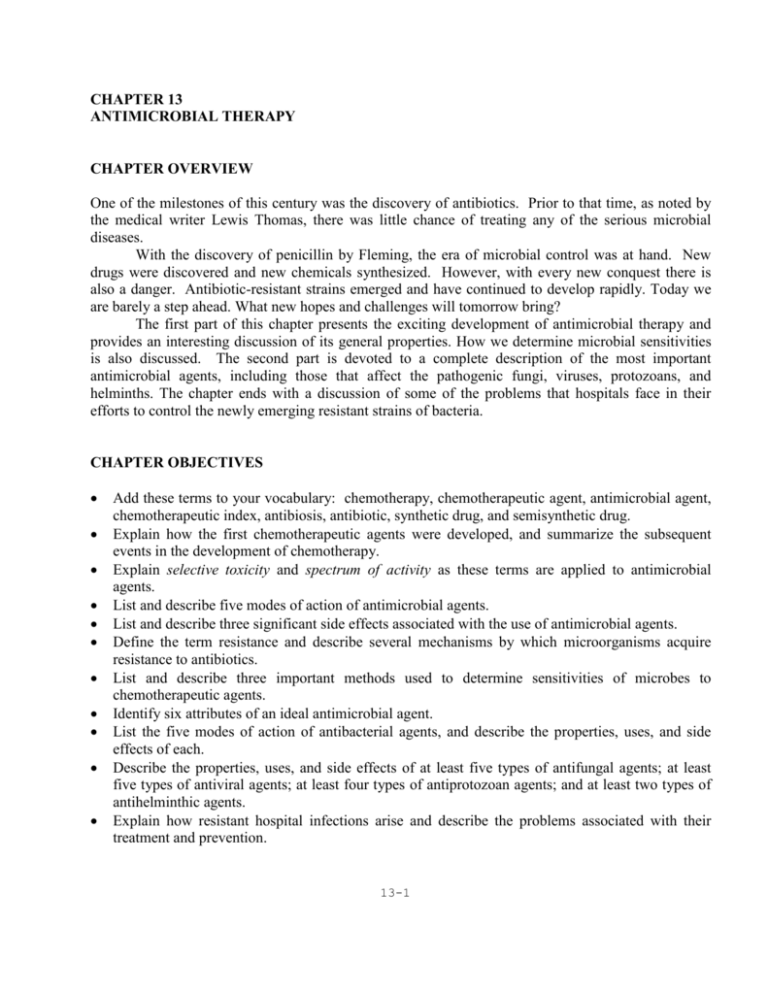
CHAPTER 13 ANTIMICROBIAL THERAPY CHAPTER OVERVIEW One of the milestones of this century was the discovery of antibiotics. Prior to that time, as noted by the medical writer Lewis Thomas, there was little chance of treating any of the serious microbial diseases. With the discovery of penicillin by Fleming, the era of microbial control was at hand. New drugs were discovered and new chemicals synthesized. However, with every new conquest there is also a danger. Antibiotic-resistant strains emerged and have continued to develop rapidly. Today we are barely a step ahead. What new hopes and challenges will tomorrow bring? The first part of this chapter presents the exciting development of antimicrobial therapy and provides an interesting discussion of its general properties. How we determine microbial sensitivities is also discussed. The second part is devoted to a complete description of the most important antimicrobial agents, including those that affect the pathogenic fungi, viruses, protozoans, and helminths. The chapter ends with a discussion of some of the problems that hospitals face in their efforts to control the newly emerging resistant strains of bacteria. CHAPTER OBJECTIVES Add these terms to your vocabulary: chemotherapy, chemotherapeutic agent, antimicrobial agent, chemotherapeutic index, antibiosis, antibiotic, synthetic drug, and semisynthetic drug. Explain how the first chemotherapeutic agents were developed, and summarize the subsequent events in the development of chemotherapy. Explain selective toxicity and spectrum of activity as these terms are applied to antimicrobial agents. List and describe five modes of action of antimicrobial agents. List and describe three significant side effects associated with the use of antimicrobial agents. Define the term resistance and describe several mechanisms by which microorganisms acquire resistance to antibiotics. List and describe three important methods used to determine sensitivities of microbes to chemotherapeutic agents. Identify six attributes of an ideal antimicrobial agent. List the five modes of action of antibacterial agents, and describe the properties, uses, and side effects of each. Describe the properties, uses, and side effects of at least five types of antifungal agents; at least five types of antiviral agents; at least four types of antiprotozoan agents; and at least two types of antihelminthic agents. Explain how resistant hospital infections arise and describe the problems associated with their treatment and prevention. 13-1 CHAPTER OUTLINE I. Antimicrobial Chemotherapy A. General features B. Terms 1. Chemotherapy 2. Chemotherapeutic agent 3. Antimicrobial agents 4. Antibiotics 5. Synthetic drugs 6. Semisynthetic drugs II. History of Chemotherapy A. Early history B. Ehrlich's contributions C. Domagk's discoveries and the development of sulfa drugs D. Fleming's discoveries III. General Properties of Antimicrobial Agents A. Selective toxicity 1. Selective toxicity 2. Therapeutic dosage level 3. Chemotherapeutic index B. Spectrum of activity 1. Broad spectrum 2. Narrow spectrum C. Modes of action 1. Inhibition of cell wall synthesis 2. Disruption of cell membrane function 3. Inhibition of protein synthesis 4. Inhibition of nucleic acid synthesis 5. Action as antimetabolites a. Competitive inhibition b. Molecular mimicry D. Kinds of side effects 1. Toxicity 2. Allergy 3. Disruption of normal microbiota E. Resistance of microorganisms 1. Definition 2. How resistance is acquired a. Nongenetic resistance b. Genetic resistance 3. Mechanisms of resistance a. Alteration of targets 13-2 4. 5. 6. b. Alteration of membrane permeability c. Development of enzymes d. Alteration of an enzyme e. Alteration of a metabolic pathway First, second, and third-line drugs Cross-resistance Limiting drug resistance a. Synergism b. Antagonism IV. Determination of Microbial Sensitivities to Antimicrobial Agents A. Disk diffusion (Kirby-Bauer) methods B. Dilution methods 1. Minimum inhibitory concentration 2. Minimum bactericidal concentration C. Serum killing power D. Automated methods V. Attributes of an Ideal Antimicrobial Agent A. Solubility in body fluids B. Selective toxicity C. Toxicity not easily altered D. Nonallergenic E. Stability F. No Resistance G. Long shelf life H. Reasonable cost VI. Antibacterial Agents A. Sources of antibiotics B. Inhibitors of cell wall synthesis 1. Penicillins 2. Cephalosporins 3. Other antibacterial agents that act on cell walls C. Disrupters of cell membranes 1. Polymyxins 2. Tyrocidins D. Inhibitors of protein synthesis 1. Aminoglycosides 2. Tetracyclines 3. Chloramphenicol 4. Other antibacterial agents that affect protein synthesis a. Macrolides b. Lincosamides 13-3 E. F. VII. Inhibitors of nucleic acid synthesis 1. Rifampin 2. Quinolones Antimetabolites and other antibacterial agents 1. Sulfonamides 2. Isoniazid 3. Ethambutol 4. Nitrofurans Antifungal Agents A. Imidazoles and triazoles B. Polyenes 1. Amphotericin B 2. Nystatin C. Griseofulvin D. Other antifungal agents 1. Flucytosine 2. Tolnaftate 3. Terbinafine VIII. Antiviral Agents A. Purine and pyrimidine analogues 1. Idoxuridine and trifluridine 2. Vidarabine 3. Ribavirin 4. Acyclovir 5. Ganciclovir 6. Zidovudine B. Amantadine C. Treatment of AIDS D. Interferon and immunoenhancers 1. Levamisole 2. Inosiplex IX. Antiprotozoan Agents A. Quinine B. Chloroquine and primaquine C. Metronidazole D. Other antiprotozoan agents 1. Pyrimethamine 2. Suramin sodium X. Antihelminthic Agents A. Niclosamide B. Mebendazole 13-4 C. XI. Other antihelminthic agents 1. Piperazine 2. Ivermectin Special Problems with Resistant Hospital Infections A. Development of resistance strains B. Problems of control C. Methods of treatment Web Destinations http://www.cdc.gov/drugresistance/ This comprehensive web site at the CDC provides information about antibiotic resistance. http://www.hopkins-abxguide.org/ This web site is an searchable antibiotic reference guide produced by the Johns Hopkins infectious disease department http://www.chiro.org/LINKS/FULL/Challenge_of_Antibiotic_Resistance.html This site makes available a Scientific American article on bacterial resistance. http://www.cellsalive.com/pen.htm The Cells Alive! site offers numerous images of microbes and has a video clip of penicillin killing a bacterium. http://www.fda.gov/fdac/features/795_antibio.html This FDA site provides information and links to antibiotic resistance topics and related subjects. 13-5
